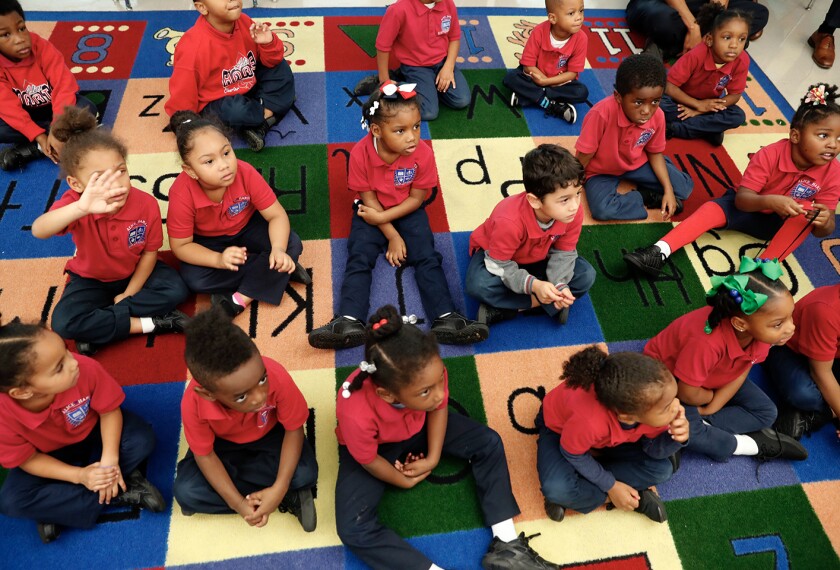There’s no trendier cause in education policy than promoting increased funding for early-childhood education. President Barack Obama has made universal access to prekindergarten the principal education policy objective of his second term, and the recently passed federal spending bill includes a $1 billion increase in spending on early-childhood education. At the state level, governors from both parties are advocating for new state-level pre-K spending, even in the face of current budget constraints. And New York City’s new mayor, Bill de Blasio, won the election promising to raise taxes on incomes over $500,000, in part to fund universal pre-K.
Policymakers are focused on early-childhood education for a good reason. Studies have consistently shown that attending high-quality preschool programs makes students more likely to be successful in elementary school, middle school, and high school. And yet, what advocates of more spending on early-childhood education often neglect to note is that the government’s record of actually producing high-quality pre-K programs is mixed at best. For instance, a 2010 U.S. Department of Health and Human Services study of Head Start—the country’s largest government-sponsored preschool program—found that by 1st grade, economically disadvantaged students with access to Head Start demonstrated almost no greater cognitive or emotional development than demographically similar students without access.

Government-funded prekindergarten has failed to deliver consistent results because grants are distributed from federal and state governments to early-childhood education programs, which ends up holding providers accountable to bureaucracies rather than to students and their families.
Head Start providers seeking federal funding are assessed for compliance with hundreds of arcane procedural regulations, such as the Kafkaesque requirement that “a variety of food is served which broadens each child’s food experiences.” Effectiveness at broadening a 3-year-old’s culinary horizons hardly seems the best criterion for evaluating early-childhood education providers. Many states also face inexplicable scenarios. For example, a June 2013 report from the Missouri state auditor found that that state’s grant process for early-childhood education involved conflicts of interest and regularly provided funding for programs with empty seats.
What really drives impact in early-childhood education is the quality of on-the-ground providers.”
Federal and state officials should replace the grant-based model with a student-based model that allocates a certain amount of funding for each child, allowing families to “carry” that money to their provider of choice. Funding would be limited to early-childhood education providers who do not charge tuition, distinguishing it from private school vouchers. To ensure equity, the student allocation formula should provide additional per-pupil funds for children whose education is more expensive, such as those who live in extreme poverty and those with disabilities.
The idea behind student-based funding is built on a fairly straightforward premise that the families served by early-childhood education programs are in a better position than government bureaucrats to evaluate the quality of those programs. In this scenario, if programs were to risk losing funding because of student flight, imagine how much greater their incentive would be to win those students back. Student-based funding could eliminate wasteful spending, improve instructor professional development, encourage the adoption of innovative pedagogical and nutritional programs to attract families, and improve equity. The programs would only receive funding for students who are actually enrolled. It could also allow existing and successful high-quality programs to access funding more easily in order to expand.
At the K-12 level, several districts have seen positive results after adopting student-based funding models. The San Francisco Unified School District instituted student-based budgeting in 2002, and by 2008 the percent of students who scored “proficient” or “advanced” on the California Standards Test rose from 35 percent to 56 percent in English/language arts and from 37 percent to 62 percent in math. San Francisco’s student-based budgeting formula also increased the proportion of district education spending allocated to high-poverty elementary and middle schools relative to low-poverty elementary and middle schools. Similarly, the school district of Hartford, Conn., instituted student-based budgeting in 2006. By 2011, the district’s high school graduation rate had increased from 29 percent to 52 percent, and 3rd grade reading proficiency increased from 23 percent to 53 percent. In these instances, student-based budgeting allowed for the alignment of resource allocation to the school structure, creating greater equity with greater accountability.
Policymakers are right to be focused on increasing access to high-quality early-childhood education, but throwing money at the problem won’t get the job done. We need to spend in a way that provides government-funded preschool providers with incentives to meet the needs of the families they serve, not those of government bureaucrats.




